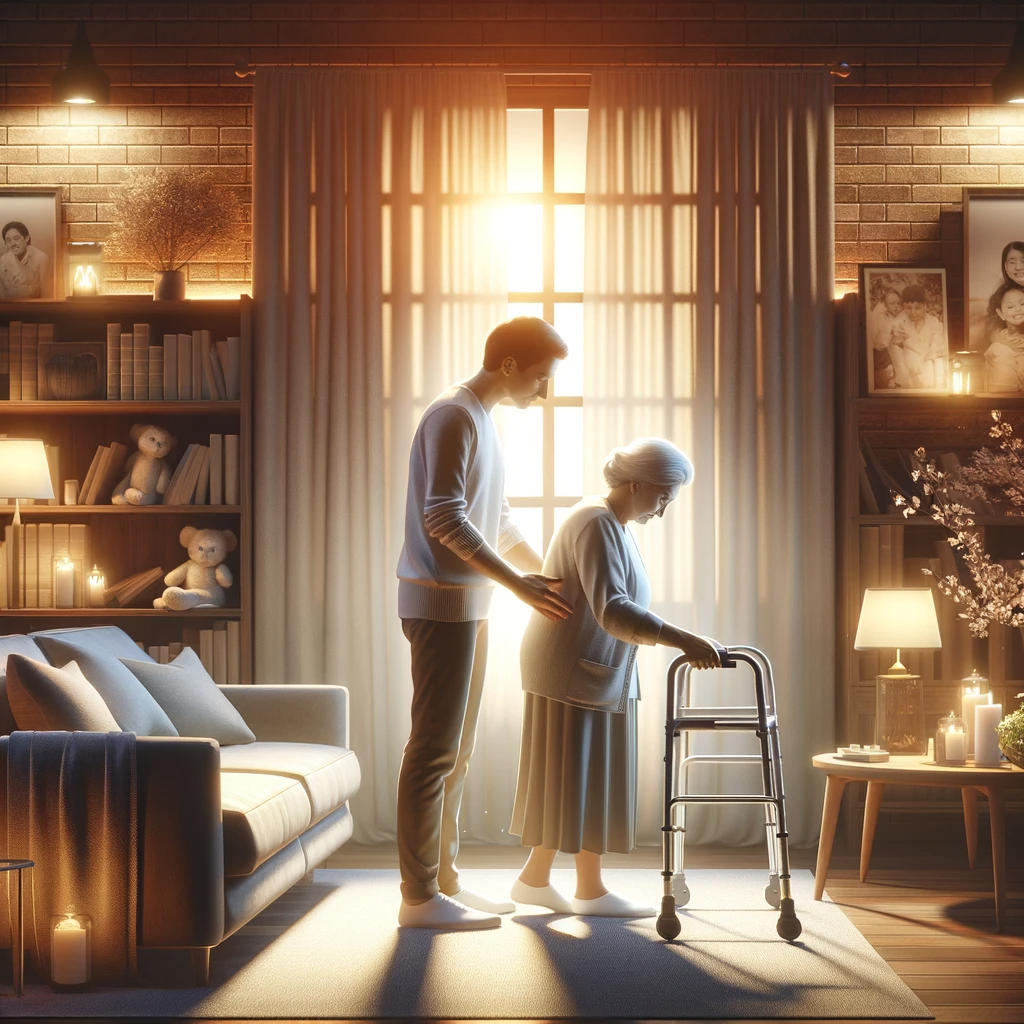How to Deal with a Bipolar Mother: A Guide to Caring for Seniors with Bipolar Disorder
Caring for an aging parent with bipolar disorder can be difficult. Learn about the symptoms, challenges, and strategies for coping with this mental illness and providing safe care for your loved one. Find support and resources to help you through the process.

Definition and Symptoms of Bipolar Disorder
Bipolar disorder is a mental health condition characterized by extreme mood swings that include emotional highs (mania or hypomania) and lows (depression). These mood swings can affect sleep, energy, activity, judgment, behavior, and the ability to think clearly. Recognizing these mental health conditions is crucial for understanding the potential impact on individuals and their families.
Types of Bipolar Disorder
There are several types of bipolar disorder, including Bipolar I, Bipolar II, and Cyclothymic Disorder, each with its own pattern of mood swings and severity. It is important to consult a mental health professional for proper diagnosis and treatment to manage these complex conditions effectively
Understanding Bipolar Disorder
Definition and Symptoms of Bipolar Disorder
Bipolar disorder is a mental health disorder characterized by extreme mood swings that can range from manic highs to depressive lows. These mood swings can significantly impact an individual’s daily life, affecting their energy levels, activity, and overall mental health. During a manic episode, a person with bipolar disorder may feel elated, irritable, and unusually energetic. They might engage in impulsive behaviors, have racing thoughts, and experience a decreased need for sleep. Conversely, during a depressive episode, they may feel overwhelming sadness, hopelessness, and a lack of energy, often losing interest in activities they once enjoyed. Understanding these symptoms is crucial for recognizing and managing bipolar disorder effectively.
Types of Bipolar Disorder
Bipolar disorder encompasses several types, each with distinct characteristics:
- Bipolar I Disorder: This type is marked by manic episodes that last at least seven days or are so severe that they require hospitalization. Depressive episodes often occur as well, typically lasting at least two weeks.
- Bipolar II Disorder: Individuals with this type experience depressive episodes and hypomanic episodes, which are less severe than full manic episodes but still involve elevated mood and increased activity.
- Cyclothymic Disorder: This type involves periods of hypomania and depression that last for at least two years, but the symptoms are not as intense as those seen in Bipolar I or II disorders.
- Other Specified Bipolar and Related Disorders: This category includes conditions that do not meet the full criteria for Bipolar I or II but still cause significant distress and impairment in daily functioning.
Understanding the different types of bipolar disorder can help in identifying the specific challenges and needs of individuals, allowing for more tailored and effective mental health treatment.
Effects of Bipolar Disorder on Seniors
Physical and Cognitive Consequences
Bipolar disorder can have profound physical and cognitive consequences for seniors. Older adults with this mental health condition are at a higher risk of developing chronic medical issues such as diabetes, cardiovascular disease, and obesity. These physical health problems can be exacerbated by the mood swings associated with bipolar disorder, making it even more challenging to manage overall health.
Cognitively, bipolar disorder can lead to difficulties with memory, attention, and decision-making, particularly in older adults. This cognitive decline can affect their ability to perform daily tasks and maintain independence. Additionally, the medications used to treat bipolar disorder can have side effects that impact physical health, such as weight gain, tremors, and an increased risk of osteoporosis.
To mitigate these effects, it is essential for seniors with bipolar disorder to work closely with their healthcare providers. Regular monitoring of physical health, cognitive function, and medication side effects is crucial. Implementing lifestyle changes, such as engaging in regular exercise, maintaining a healthy diet, and practicing stress management techniques, can also play a significant role in managing the condition and improving overall well-being.
By understanding and addressing the physical and cognitive consequences of bipolar disorder, seniors and their caregivers can take proactive steps to enhance quality of life and maintain health and independence.
Bipolar Disorder in the Elderly
Tips for Caring for Someone with Bipolar Disorder
Caring for an aging parent with bipolar disorder can be difficult. Learn about the symptoms, challenges, and strategies for coping with this mental illness and providing safe care for your loved one. Find support and resources to help you through the process.
Caring for a Loved one that has BiPolar Disorder?
Caring for a loved one with bipolar disorder, also known as manic depression, presents unique challenges. This can be especially true when providing care for an aging bipolar mother or bipolar parent. The mood fluctuations, ranging from manic highs to severe lows of depression, can be demanding to navigate.
Family-focused therapy (FFT) is beneficial for both the parent and the family members, helping them cope with the challenges and effects of bipolar disorder.
Being a family caregiver comes with its own set of difficulties, including feelings of isolation and being overwhelmed. Providing care for an elderly family member with bipolar disorder can trigger emotions of anger and hopelessness.
Bipolar disorder involves alternating periods of depression and mania, which manifests as elated or irritable moods with increased energy levels.
Bipolar Disorder in the Elderly
Understanding the Symptoms:
Depression:
Over a span of at least two weeks, five or more of the following symptoms may be observed:
· Frequent feelings of misery and sadness.
· Diminished interest or pleasure in once-enjoyable activities.
· Heightened anxiety or irritability.
· Difficulties in concentration and memory.
· Ongoing fatigue.
· Feelings of guilt.
· Sleeping too much or too little.
· Changes in appetite, either excessive or minimal.
· Experiencing unexplained physical discomfort.
· Engaging in alcohol or substance abuse.
· Thoughts of death or suicide.
Mania:
· A minimum of three of the following symptoms might be present:
· Escalated energy levels and reduced need for sleep.
· Excessive irritability, euphoria, or aggressive behavior.
· Increased verbosity or pressured speech.
· Racing and disjointed thoughts.
· Impulsive actions and impaired judgment, such as excessive spending or risky behaviors.
· Inflated self-esteem.
· Elevated engagement in goal-oriented activities.
· Pronounced distractibility.
Recognizing Signs of Suicidal Thoughts:
If someone is exhibiting preoccupation with thoughts of death or suicide, it’s imperative to reach out to their healthcare professional immediately. In cases of imminent danger, dial 911 or take the person to the nearest emergency room. Additional warning signs include:
· Expressing feelings of hopelessness and worthlessness.
· Demonstrating sudden calmness during a depressive episode.
· Making unusual contacts with loved ones.
· Taking actions to put affairs in order.
· Giving away possessions.
Children may face emotional struggles due to their parent's bipolar disorder, experiencing self-blame and guilt.
Dealing with Mania:
During manic episodes, individuals might display paranoid tendencies, embrace unrealistic ideas, indulge in excessive spending, or partake in unsafe activities. Remember that these behaviors are characteristic of a manic state, indicating that the person’s thought process is not in its normal state. While reasoning might be challenging during these times, maintaining eye contact and involving their psychiatrist is advisable to avert unsafe actions.
Hospitalization and Safety:
In some instances, hospitalization may be necessary when the person is in a manic state. Discussing behaviors and available options with the person’s healthcare provider before a crisis emerges can help ensure appropriate steps are taken to safeguard their well-being.
Coping Strategies:
Caring for someone with bipolar disorder, particularly an aging family member, is undeniably demanding. Here are some effective coping strategies:
1.Educate Yourself: Understanding bipolar disorder is the first step in managing expectations and implementing effective coping mechanisms.
2.Involve the Family: Recognize that bipolar disorder affects the entire family. Distributing caregiving responsibilities among family members can alleviate the burden on a single individual.
3.Open Communication: Consider engaging a skilled family therapist to facilitate open discussions and future care planning for the senior family member.
4.Show Understanding: Regularly reassure your loved one that you care. Individuals with bipolar disorder often struggle with negative thoughts and depressive states, so offering consistent support is vital.
5.Prioritize Self-Care: Establish limits and boundaries to avoid caregiver burnout. Take occasional breaks from caregiving and seek medical help if needed.
6.Seek Social Support: Caring for someone around the clock can be isolating. Connecting with others who understand the challenges can provide valuable emotional support.
7.Address Legal Matters: Ensure all necessary legal paperwork is in order to address potential future concerns.
Support groups are essential for caregivers, providing a community and resources to help manage the challenges of caring for someone with bipolar disorder.
Remember: You are not alone in this journey. Bipolar disorder is treatable, and many individuals can achieve stability with proper care and support.💡
Remember: You are not alone in this journey. Bipolar disorder is treatable, and many individuals can achieve stability with proper care and support
Our Resources section can help you find the information and tools that you need. We have courses, videos, checklists, guidebooks, cheat sheets, how-to guides and more.
You can get started by clicking on the link below. We know that taking care of a loved one is hard work, but with our help you can get the support that you need.
Click here to go to Resources Section now!
You might also like this article:












